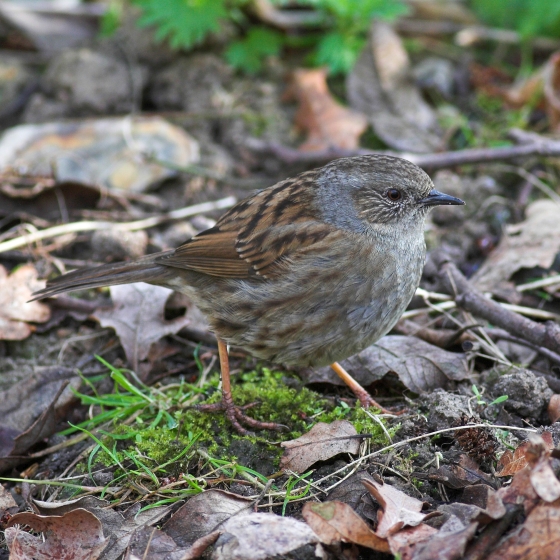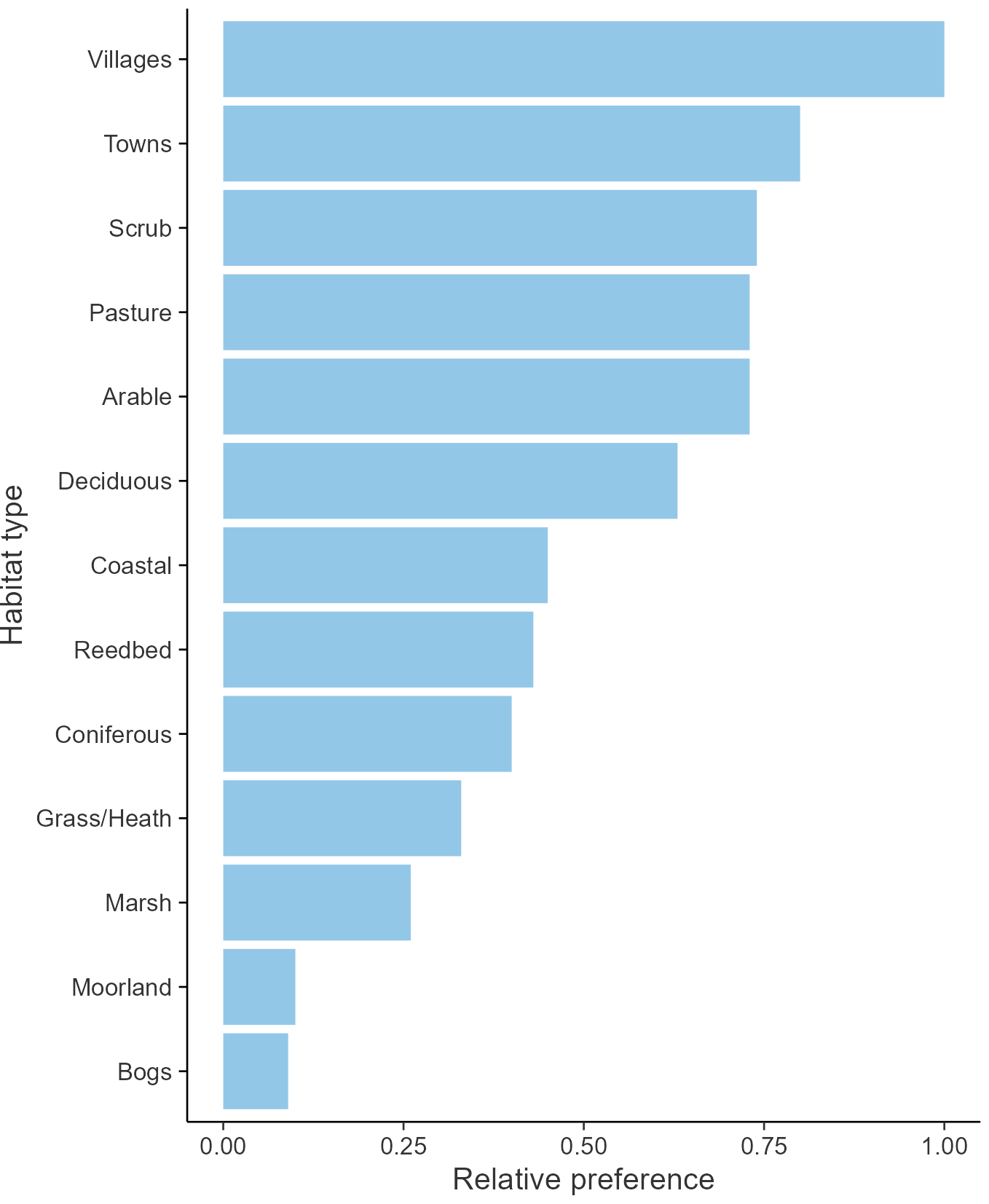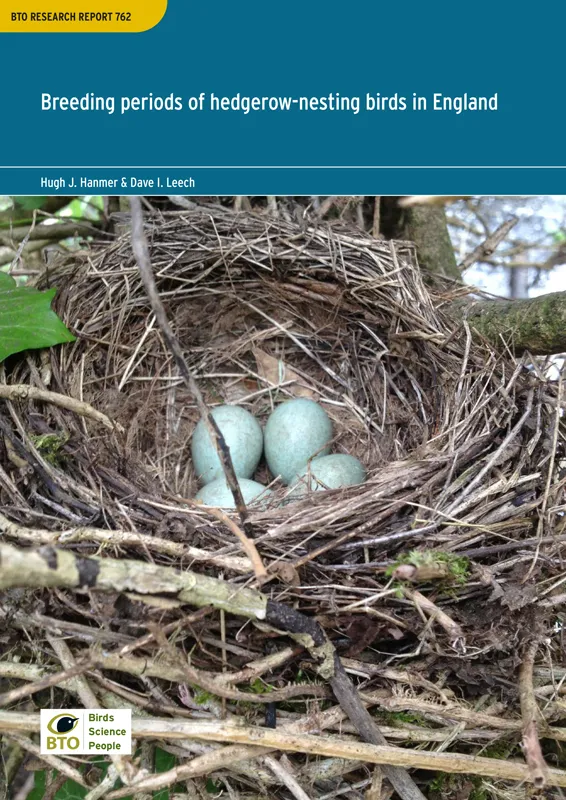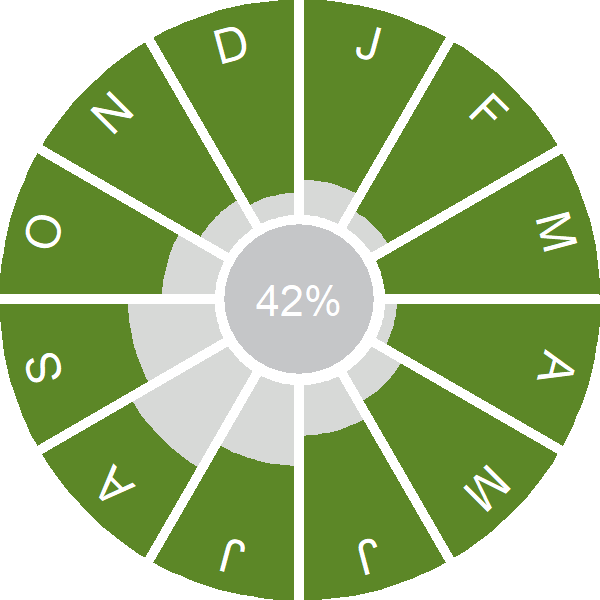Dunnock

Introduction
This 'little brown job' of a bird can be found throughout Britain & Ireland year round, except on the highest Scottish peaks.
UK Dunnock numbers fell sharply in the 1970s and 1980s, perhaps linked to low winter food availability. The trend has since stabilised, although recent years show evidence of another downturn. The species is on the UK Amber List.
Dunnocks are known for their interesting sex lives, with both males and females mating with more than one partner. They are quite shy and often seen on the ground, under low vegetation, giving them the colloquial name 'hedge sparrow'. In spring, males can be found on high perches singing a repetitive, squeaky song.
- Our Trends Explorer gives you the latest insight into how this species' population is changing.

Key Stats
Identification
ID Videos
This section features BTO training videos headlining this species, or featuring it as a potential confusion species.
#BirdSongBasics: House Sparrow and Dunnock
Sparrows
#BirdSongBasics: Dunnock and Wren
GBW: House Sparrow and Dunnock
Songs and Calls
Song:
Call:
Young call:
Status and Trends
Conservation Status
Population Change
Dunnock abundance fell substantially between the mid 1970s and mid 1980s, after a period of population stability. Some recovery has occurred throughout the UK since the late 1990s, but the species still meets amber-list criteria. The BBS map of change in relative density between 1994-96 and 2007-09 indicates that increase over that period occurred mainly in Northern Ireland and in northwestern Britain. Clutch and brood sizes, and the number of fledglings per breeding attempt all increased as the population fell and have fallen again during the recent period of partial recovery. There has been a decline across Europe since 1980 (PECBMS: PECBMS 2020a>).
Distribution
The resident Dunnock occurs in 93% of 10-km squares both in winter and the in breeding season, being absent only from treeless stretches of the Scottish Highlands, and parts of the Outer Hebrides and Northern Isles. Densities in both seasons are highest in south and east Ireland and throughout much of lowland England.
Occupied 10-km squares in UK
2007/08–10/11
or view it on Bird Atlas Mapstore.
2008–11
or view it on Bird Atlas Mapstore.
European Distribution Map
Distribution Change
Dunnock distribution has changed little since the 1970s; some apparent gains in the uplands of northwest Scotland, on Orkney and the Outer Hebrides may reflect improved coverage. However, relative abundance has increased in many parts of Britain & Ireland since the early 1990s.
Change in occupied 10-km squares in the UK
from 1981–84 to 2007–11
or view it on Bird Atlas Mapstore.
from 1968–72 to 2008–11
or view it on Bird Atlas Mapstore.
Seasonality
Dunnock is recorded throughout the year though can be more skulking after breeding in late summer and early autumn.
Weekly pattern of occurrence
The graph shows when the species is present in the UK, with taller bars indicating a higher likelihood of encountering the species in appropriate regions and habitats.

Habitats
Breeding season habitats
Relative frequency by habitat
The graph shows the habitats occupied in the breeding season, with the most utilised habitats shown at the top. Bars of similar size indicate the species is equally likely to be recorded in those habitats.

Movement
Britain & Ireland movement
Foreign locations of birds ringed or recovered in Britain & Ireland
Dots show the foreign destinations of birds ringed in Britain & Ireland, and the origins of birds ringed overseas that were subsequently recaptured, resighted or found dead in Britain & Ireland. Dot colours indicate the time of year that the species was present at the location.
- Winter (Nov-Feb)
- Spring (Mar-Apr)
- Summer (May-Jul)
- Autumn (Aug-Oct)

European movements
EuroBirdPortal uses birdwatcher's records, such as those logged in BirdTrack to map the flows of birds as they arrive and depart Europe. See maps for this species here.
The Eurasian-African Migration Atlas shows movements of individual birds ringed or recovered in Europe. See maps for this species here.
Biology
Productivity and Nesting
Nesting timing
Egg measurements
Clutch Size
Incubation
Fledging
Survival and Longevity
Survival is shown as the proportion of birds surviving from one year to the next and is derived from bird ringing data. It can also be used to estimate how long birds typically live.
View number ringed each year in the Online Ringing Report.
Lifespan
Survival of adults
Survival of juveniles
Biometrics
Wing length and body weights are from live birds (source).
Wing length
Body weight
Ring Size
Classification, names and codes
Classification and Codes
- Order: Passeriformes
- Family: Prunellidae
- Scientific name: Prunella modularis
- Authority: Linnaeus, 1758
- BTO 2-letter code: D.
- BTO 5-letter code: DUNNO
- Euring code number: 10840
Alternate species names
- Catalan: pardal de bardissa
- Czech: pevuška modrá
- Danish: Jernspurv
- Dutch: Heggenmus
- Estonian: võsaraat
- Finnish: rautiainen
- French: Accenteur mouchet
- Gaelic: Gealbhonn-gàraidh
- German: Heckenbraunelle
- Hungarian: erdei szürkebegy
- Icelandic: Runntítla
- Irish: Donnóg
- Italian: Passera scopaiola
- Latvian: pelkajite
- Lithuanian: paprastasis eršketžvirblis
- Norwegian: Jernspurv
- Polish: (plochacz) pokrzywnica
- Portuguese: ferreirinha
- Slovak: vrchárka modrá
- Slovenian: siva pevka
- Spanish: Acentor común
- Swedish: järnsparv
- Welsh: Llwyd y Gwrych
- English folkname(s): Scrubber, Shufflewing, Creepie
Research
Causes of Change and Solutions
Causes of change
The decline of the species between the mid 1970s and mid 1980s is likely to be due to several factors, but strong experimental evidence in farmland areas suggests that this may be linked to reduced winter food availability. This reflects similar results found for other species that suffer a 'hungry gap' in February and March.
Further information on causes of change
The cause of the decline between the mid 1970s and mid 1980s is unknown, but a recently constructed integrated population model suggests that variation in adult survival plays a key role in determining annual population change (Robinson et al. 2014). It is possible that decline was limited to the farmland and woodland habitats that were covered by CBC, prior to the inception of BBS in 1994.
Feeding experiments have revealed that the use Dunnocks make of farmland feeding stations peaks after mid February, as natural food becomes depleted, suggesting that food availability on farmland is a limiting factor in the population (Siriwardena et al. 2007, 2008). This reflects similar results found for other farmland birds that experience a 'hungry gap' in February and March (Siriwardena et al. 2008). Evidence from the study also suggested that breeding abundance was stable where the use of provided food was high, although this may be a density-dependent result as high use occurred at high abundance (Siriwardena et al. 2007).
The CBC trend in woodland plots suggested that the species had declined by 58% between 1966 and 2000 (Fuller et al. 2005). The most likely cause for this decline is loss of understorey due to canopy closure, in the absence of forest management and especially to increasing browsing pressure from deer (Gill & Fuller 2007). In Bradfield Woods, Suffolk, Dunnocks responded negatively to browsing pressure (Holt et al. 2011). Shrub density has been identified as the most important predictor of Dunnock abundance at this site (Fuller & Henderson 1992).
Information about conservation actions
The most likely driver of the decline of this species on farmland during the late 1970s and 1980s was agricultural intensification and reduced winter food availability. The Dunnock is affected by the 'hunger gap' in late winter (Siriwardena et al. 2008; see Causes of Change section, above) and therefore ensuring food is available after mid-February is likely to be particularly important. Conservation actions and agri-environment options which could help achieve this include supplementary feeding (Siriwardena et al. 2007) and other actions which increase winter food supply such as the planting of wild bird seed cover, the retention of stubble fields, and the use of buffer strips, conservation headlands, set-aside and similar habitats to increase the availability of natural seed resources.
The species is also declining in woodland, where the main cause is likely to be the closure of the canopy and increased levels of deer browsing leading to loss of shrubs in the understorey. Therefore, active woodland management to create a more open canopy and to control deer numbers may create better habitat conditions for Dunnocks.
Publications (1)
Breeding periods of hedgerow-nesting birds in England
Author: Hanmer, H.J. & Leech, D.I.
Published: Spring 2024
Hedgerows form an important semi-natural habitat for birds and other wildlife in English farmland landscapes, in addition to providing other benefits to farming. Hedgerows are currently maintained through annual or multi-annual cutting cycles, the timing of which could have consequences for hedgerow-breeding birds. The aim of this report is to assess the impacts on nesting birds should the duration of the management period be changed, by quantifying the length of the current breeding season for 15 species of songbird likely to nest in farmland hedges. These species are Blackbird, Blackcap, Bullfinch, Chaffinch, Dunnock, Garden Warbler, Goldfinch, Greenfinch, Linnet, Long-tailed Tit, Robin, Song Thrush, Whitethroat, Wren and Yellowhammer.
05.03.24
BTO Research Reports

More Evidence
More evidence from Conservation Evidence.com
Partners
Citing BirdFacts
If you wish to cite particular content in this page (e.g. a specific value) it is best to use the original sources as linked in the page. For a more general citation of the whole page please use: BTO (20XX) BirdFacts Species: profiles of birds occurring in the United Kingdom. BTO, Thetford (www.bto.org/birdfacts, accessed on xx/xx/xxxx).

